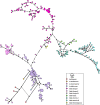Insight into the evolutionary and domesticated history of the most widely cultivated mushroom Agaricus bisporus via mitogenome sequences of 361 global strains
- PMID: 37020265
- PMCID: PMC10077685
- DOI: 10.1186/s12864-023-09257-w
Insight into the evolutionary and domesticated history of the most widely cultivated mushroom Agaricus bisporus via mitogenome sequences of 361 global strains
Abstract
Agaricus bisporus is the most widely cultivated edible mushroom in the world with a only around three hundred years known history of cultivation. Therefore, it represents an ideal organism not only to investigate the natural evolutionary history but also the understanding on the evolution going back to the early era of domestication. In this study, we generated the mitochondrial genome sequences of 352 A. bisporus strains and 9 strains from 4 closely related species around the world. The population mitogenomic study revealed all A. bisporus strains can be divided into seven clades, and all domesticated cultivars present only in two of those clades. The molecular dating analysis showed this species origin in Europe on 4.6 Ma and we proposed the main dispersal routes. The detailed mitogenome structure studies showed that the insertion of the plasmid-derived dpo gene caused a long fragment (MIR) inversion, and the distributions of the fragments of dpo gene were strictly in correspondence with these seven clades. Our studies also showed A. bisporus population contains 30 intron distribution patterns (IDPs), while all cultivars contain only two IDPs, which clearly exhibit intron loss compared to the others. Either the loss occurred before or after domestication, that could suggest that the change facilitates their adaptation to the cultivated environment.
Keywords: Button mushroom; Domestication; Mitogenome; Phylogenomic; Population genomics.
© 2023. The Author(s).
Conflict of interest statement
The authors declare that they have no competing interests.
Figures








Similar articles
-
Whole Genome Sequence of the Commercially Relevant Mushroom Strain Agaricus bisporus var. bisporus ARP23.G3 (Bethesda). 2019 Oct 7;9(10):3057-3066. doi: 10.1534/g3.119.400563. G3 (Bethesda). 2019. PMID: 31371382 Free PMC article.
-
A detailed analysis of the recombination landscape of the button mushroom Agaricus bisporus var. bisporus.Fungal Genet Biol. 2016 Aug;93:35-45. doi: 10.1016/j.fgb.2016.06.001. Epub 2016 Jun 8. Fungal Genet Biol. 2016. PMID: 27288752
-
New Germplasms of the Culinary-Medicinal Button Mushroom, Agaricus bisporus (Agaricomycetes): Two Wild Strains from the Tibetan Plateau (China).Int J Med Mushrooms. 2017;19(2):145-154. doi: 10.1615/IntJMedMushrooms.v19.i2.60. Int J Med Mushrooms. 2017. PMID: 28436323
-
Developments in breeding of Agaricus bisporus var. bisporus: progress made and technical and legal hurdles to take.Appl Microbiol Biotechnol. 2017 Mar;101(5):1819-1829. doi: 10.1007/s00253-017-8102-2. Epub 2017 Jan 28. Appl Microbiol Biotechnol. 2017. PMID: 28130632 Free PMC article. Review.
-
Critical Factors Involved in Primordia Building in Agaricus bisporus: A Review.Molecules. 2020 Jun 29;25(13):2984. doi: 10.3390/molecules25132984. Molecules. 2020. PMID: 32610638 Free PMC article. Review.
Cited by
-
Wood-loving magic mushrooms from Australia are saprotrophic invaders in the Northern Hemisphere.Fungal Syst Evol. 2024 Dec;14:209-217. doi: 10.3114/fuse.2024.14.14. Epub 2024 Jul 19. Fungal Syst Evol. 2024. PMID: 39830294 Free PMC article.
-
Determining Gene Order Patterns in the Suillus and Boletales through Comparative Analysis of Their Mitogenomes.Int J Mol Sci. 2024 Sep 4;25(17):9597. doi: 10.3390/ijms25179597. Int J Mol Sci. 2024. PMID: 39273542 Free PMC article.
-
Comparative and phylogenetic analyses using mitogenomes revealed gene re-arrangement of Boletaceae (Boletales).IMA Fungus. 2025 Aug 15;16:e154192. doi: 10.3897/imafungus.16.154192. eCollection 2025. IMA Fungus. 2025. PMID: 40860166 Free PMC article.
-
Comparative analyses of Pleurotus pulmonarius mitochondrial genomes reveal two major lineages of mini oyster mushroom cultivars.Comput Struct Biotechnol J. 2024 Feb 1;23:905-917. doi: 10.1016/j.csbj.2024.01.021. eCollection 2024 Dec. Comput Struct Biotechnol J. 2024. PMID: 38370975 Free PMC article.
-
From 'Farm to Fork': Exploring the Potential of Nutrient-Rich and Stress-Resilient Emergent Crops for Sustainable and Healthy Food in the Mediterranean Region in the Face of Climate Change Challenges.Plants (Basel). 2024 Jul 11;13(14):1914. doi: 10.3390/plants13141914. Plants (Basel). 2024. PMID: 39065441 Free PMC article. Review.
References
-
- Huang X, Kurata N, Wei X, Wang ZX, Wang A, Zhao Q, Zhao Y, Liu K, Lu H, Li W, Guo Y, Lu Y, Zhou C, Fan D, Weng Q, Zhu C, Huang T, Zhang L, Wang Y, Feng L, Furuumi H, Kubo T, Miyabayashi T, Yuan X, Xu Q, Dong G, Zhan Q, Li C, Fujiyama A, Toyoda A, Lu T, Feng Q, Qian Q, Li J, Han B. A map of rice genome variation reveals the origin of cultivated rice. Nature. 2012;490:497–501. doi: 10.1038/nature11532. - DOI - PMC - PubMed
-
- Wang GD, Zhai W, Yang HC, Wang L, Zhong L, Liu YH, Fan RX, Yin TT, Zhu CL, Poyarkov AD, Irwin DM, Hytonen MK, Lohi H, Wu CI, Savolainen P, Zhang YP. Out of southern East Asia: the natural history of domestic dogs across the world. Cell Res. 2016;26:21–33. doi: 10.1038/cr.2015.147. - DOI - PMC - PubMed
-
- Peter J, De Chiara M, Friedrich A, Yue JX, Pflieger D, Bergström A, Sigwalt A, Barre B, Freel K, Llored A, Cruaud C, Labadie K, Aury JM, Istace B, Lebrigand K, Barbry P, Engelen S, Lemainque A, Wincker P, Liti G, Schacherer J. Genome evolution across 1,011 Saccharomyces cerevisiae isolates. Nature. 2018;556:339–344. doi: 10.1038/s41586-018-0030-5. - DOI - PMC - PubMed
-
- Imbach EJ. Pilzflora des Kantons Luzern und der angrenzen Innerschweiz. Mitteilungen der naturforschenden Gesellschaft Luzern (in German) 1946;15:5–85.
MeSH terms
Supplementary concepts
LinkOut - more resources
Full Text Sources

